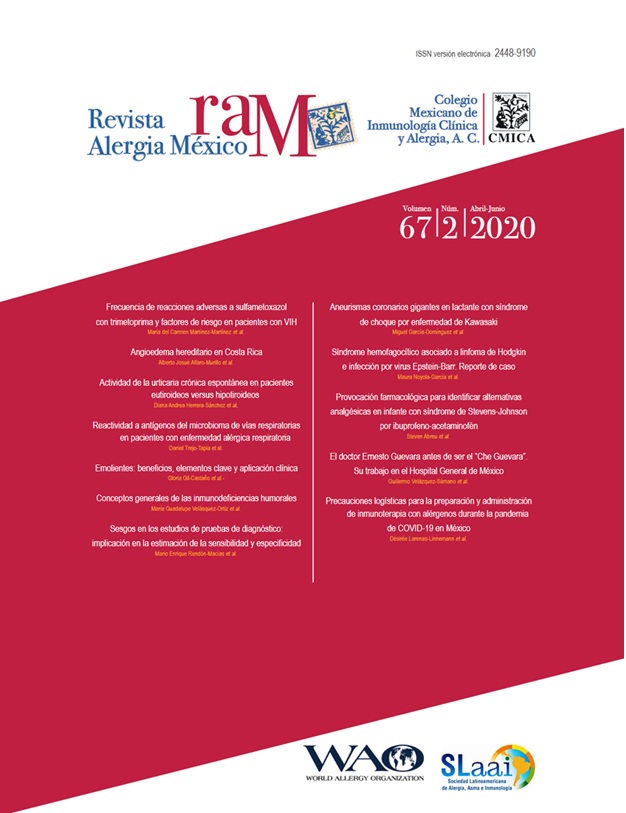Resumen
Antecedentes: El síndrome de Stevens-Johnson es una reacción farmacológica cutánea grave, potencialmente mortal. Su manejo incluye estricta restricción del medicamento implicado y de los fármacos estructuralmente relacionados o similares.
Caso clínico: Niña de dos años y ocho meses quien presentó síndrome de Stevens-Johnson desencadenado por acetaminofén e ibuprofeno. Debido a la restricción total de antiinflamatorios no esteroideos y con el fin de establecer alternativas antipiréticas, se realizó provocación oral con dosis usual de nimesulida oral, la cual fue negativa para reacciones inmediatas y tardías. Para ofrecer una alternativa parenteral, se efectuó prueba de provocación con dipirona intravenosa, con vigilancia intrahospitalaria por 48 horas en un protocolo de administración de 10, 30 y 60 %, una dosis cada hora, para un total de 400 mg. La prueba de provocación fue negativa para reacciones inmediatas y tardías. Se indicó nimesulida oral o dipirona oral o parenteral en caso de requerir medicación analgésica, antiinflamatoria o antipirética.
Conclusión: En la infancia, los cuadros febriles son comunes y el control de este síntoma es fundamental, de tal forma que si en un infante se identifica alergia a los antiinflamatorios no esteroideos y al acetaminofén, eso supondrá afectación en la calidad de vida.
Referencias
Stevens M, Johnson C. A new eruptive fever associated with stomatitis and ophthalmia: Report of two cases in children. Am. J. Dis. Child. 1922;24(6):526-533. DOI: 10.1001/archpedi.1922.04120120077005
White KD, Abe R, Ardern-Jones M, Beachkofsky T, Bouchard C, Carleton B, et al. SJS/TEN 2017: building multidisciplinary networks to drive science and translation. J Allergy Clin Immunol. Pract. 2018;6(1):38-69. DOI: 10.1016/j.jaip.2017.11.023
Adegbenro-Omotuyi A, Princess O, Precious A, Favour A, Precious E, Olunu E, et al. Stevens-Johnson Syndrome and toxic epidermal necrolysis; extensive review of reports of drug-induced etiologies, and possible therapeutic modalities. Open Access Maced J Med Sci. 2018;6(4):730-738. DOI: 10.3889/oamjms.2018.148
Yang SC, Hu Su, Zhang SZ, Huang JW, Zhang J, Ji C, et al. The epidemiology of Stevens-Johnson syndrome and toxic epidermal necrolysis in China. J Immunol Res. 2018;2018:4320195. DOI: 10.1155/2018/4320195
Frey N, Jossi J, Bodmer M, Bircher A, Jick SS, Meier CR, et al. The epidemiology of Stevens-Johnson syndrome and toxic epidermal necrolysis in the UK. J Invest Dermatol. 2017;137(6):1240-1247. DOI: 10.1016/j.jid.2017.01.031
Hsu DY, Brieva J, Silverberg NB, Paller AS, Silverberg JI. Pediatric Stevens-Johnson syndrome and toxic epidermal necrolysis in the United States. J Am Acad Dermatol. 2017;76(5):811-817.e4. DOI: 10.1016/j.jaad.2016.12.024
Rzany B, Mockenhuupt M, Baur S, Schröder W, Stocker U, Mueller J, et al. Epidemiology of erythema exsudativum multiforme majus, Stevens-Johnson syndrome, and toxic epidermal necrolysis in Germany (1990- 1992): structure and results of a population-based registry. J Clin Epidemiol. 1996;49(7):769-773. DOI: 10.1016/0895-4356(96)00035-2
Roujeau JC, Kelly JP, Naldi L, Rzany B, Stern RS, Anderson T, et al. Medication use and the risk of Stevens-Johnson syndrome or toxic epidermal necrolysis. N Engl J Med. 1995;333(24):1600-1607. DOI: 10.1056/NEJM199512143332404
Mockenhaupt M, Viboud C, Dunant A, Naldi L, Halevy S, Sidoroff A, et al. Stevens-Johnson syndrome and toxic epidermal necrolysis: Assessment of medication risks with emphasis on recently marketed drugs. The EuroSCAR-study. J Invest Dermatol. 2008;128(1):35-44. DOI: 10.1038/sj.jid.5701033.
Rajan TV. The Gell-Coombs classification of hypersensitivity reactions: a re-interpretation. Trends Immunol. 2003;24(7):376-379. DOI: 10.1016/s1471-4906(03)00142-x
Saeed HN, Chodosh J. Immunologic mediators in Stevens-Johnson syndrome and toxic epidermal necrolysis. Semin Ophthalmol. 2016;31(1-2):85-90. DOI: 10.3109/08820538.2015.1115255
Lerch M, Mainetti C, Beretta-Piccoli BT, Harr T. Current perspectives on Stevens-Johnson syndrome and toxic epidermal necrolysis. Clin Rev Allerg Immunol. 2017;56(1):147-176. DOI: 10.1007/s12016-017-8654-z
Alerhand S, Cassella C, Koyfman A. Stevens-Johnson syndrome and toxic epidermal necrolysis in the pediatric population: a review. Pediatr Emerg Care. 2016;32(7):472-476. DOI: 10.1097/PEC.0000000000000840
Sekula P, Dunant A, Naldi L, Bouwes JN, Halevy S, Kardaun S, et al. Comprehensive survival analysis of a cohort of patients with Stevens-Johnson syndrome and toxic epidermal necrolysis. J Invest Dermatol. 2013;133(5):1197-1204. DOI: 10.1038/jid.2012.510
Fouchard N, Bertocchi M, Roujeau JC, Revuz J, Wolkenstein P, Bastuji-Garin S. SCORTEN: a severity-of-illness score for toxic epidermal necrolysis. J Invest Dermatol. 2000;115(2):149-153. DOI: 10.1046/j.1523-1747.2000.00061.x
Sassolas B, Haddad C, Dunant A, Liss Y, Bork K, Louet L, et al. ALDEN, an algorithm for assessment of drug causality in Stevens-Johnson syndrome and toxic epidermal necrolysis: comparison with case-control analysis. Clin Pharmacol Ther. 2010;88(1):60-68. DOI: 10.1038/clpt.2009.252
Wing R, MR Dor, McQuilkin PA. Fever in the pediatric patient. Emerg Med Clin North Am. 2013;31(4):1073-1096. DOI: 10.1016/j.emc.2013.07.006
Chiappini E, Bortone B, Galli L, Martino M. Guidelines for the symptomatic management of fever in children: systematic review of the literature and quality appraisal with AGREE II. BMJ Open. 2017;7(7):e015404. DOI: 10.1136/bmjopen-2016-015404
Phillips EJ, Bigliardi P, Bircher AJ, Broyles A, Chang YS, Chung WH, et al. Controversies in drug allergy: testing for delayed reactions. J Allergy Clin Immunol. 2019;143(1):66-73. DOI: 10.1016/j.jaci.2018.10.030

Esta obra está bajo una licencia internacional Creative Commons Atribución-NoComercial 4.0.
Derechos de autor 2020 Revista Alergia México





